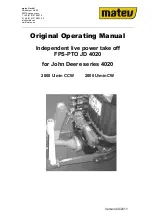
•
When the Crawler is operating,
o n l y
t h e
operator should be on it.
•
If it is necessary to make checks with the
Engine running,
always use two people
...the
operator at the controls, should be able to see
the person doing the checking.
KEEP HANDS AWAY FROM MOVING PARTS.
D A N G E R :
Never use “quick-disconnect”
type couplings on this Crawler or any of its
mating Attachments unless specified; to do so
results in the potential of rupturing hydraulic
fittings or even “blowing-up” your hydraulic
pumps!
BEFORE YOU DISMOUNT:
1) Move Track Drive Controls to neutral.
2) Push down Parking Brake and Lock.
3) Lower all equipment to the ground.
4) Stop Engine and remove the key.
SERVICE SAFETY
•
Be sure you understand a service procedure
before you work on the Crawler.
•
Unauthorized modifications to the Crawler
may impair the function and/or safety and
affect Crawler
life.
•
Do not work
under raised
e q u i p m e n t
unless it is
c o r r e c t l y
supported.
•
Before
you
work on the
Engine
or
e l e c t r i c a l
s y s t e m ,
d i s c o n n e c t
the battery’s
“ground” ( - )
terminal first!
When work is
finished, connect battery’s “ground” terminal (
- ) last.
•
When driving connecting pins, wear goggles
or safety glasses.
•
Do not run Engine while working on the
Crawler.
•
Be careful when handling any type of fuel. Do
not smoke while filling the fuel tank or working
on the fuel system.
•
Check for faulty wiring or loose connections.
•
Do not lubricate or work on the Crawler while
it is moving.
•
Release hydraulic pressure before working on
hydraulic system. Move
e v e r y
h y d r a u l i c
control lever back & forth until equipment does
not move.
•
Before using the hydraulic system, be sure
that all connections are tight and that lines are
in good condition.
•
When you work near the Track Springs,
use
extreme care
. Do not disassemble parts
unless you know the correct procedure and
have correct tools.
FIRE PREVENTION MAINTENANCE
•
Be prepared if an accident or fire should occur.
Know where the first aid kit and the fire
extinguishers are located—know how to use
them. Check fire extinguisher for correct
charge.
•
Do not smoke while refueling or handling
highly flammable material.
•
Shut off the Engine when refueling.
•
Use care in refueling if the Engine is hot.
•
Do not use open pans of gasoline or diesel
fuel for cleaning parts. Use good commercial,
nonflammable solvents.
•
Provide adequate ventilation when charging
battery.
•
Do not check battery charge by placing metal
objects across the posts.
•
Do not allow sparks or an open flame near
battery. Do not smoke near battery.
•
Never check fuel, battery electrolyte, or









































